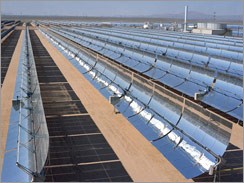
A consumer green energy program is a program that enables households to buy energy from renewable sources. By allowing consumers to purchase renewable energy, it simultaneously diverts the utilization of fossil fuels and promotes the use of renewable energy sources such as solar and wind.
Contents
- Green energy and labeling by region
- European Union
- United Kingdom
- United States
- Asia
- Small-scale green energy systems
- References
In several countries with common carrier arrangements, electricity retailing arrangements make it possible for consumers to purchase "green" electricity from either their utility or a green power provider. Electricity is considered to be green if it is produced from a source that produces relatively little pollution, and the concept is often considered equivalent to renewable energy. [1] Although electricity is the most common green energy, biomethane is sold as "green gas" in some locations. [2]
In many countries, green energy currently provides a very small amount of electricity, generally contributing less than 2 to 5% to the overall pool of electricity offered by most utility companies, electric companies, or state power pools. In some U.S. states, local governments have formed regional power purchasing pools using Community Choice Aggregation and Solar Bonds to achieve a 51% renewable mix or higher, such as in the City of San Francisco. [3]
By participating in a green energy program a consumer may be having an effect on the energy sources used and ultimately might be helping to promote and expand the use of green energy. They are also making a statement to policy makers that they are willing to pay a price premium to support renewable energy. Green energy consumers either obligate the utility companies to increase the amount of green energy that they purchase from the pool (so decreasing the amount of non-green energy they purchase), or directly fund the green energy through a green power provider. If insufficient green energy sources are available, the utility must develop new ones or contract with a third party energy supplier to provide green energy, causing more to be built. However, there is no way the consumer can check whether or not the electricity bought is "green" or otherwise.
In some countries such as the Netherlands, electricity companies guarantee to buy an equal amount of 'green power' as is being used by their green power customers. The Dutch government exempts green power from pollution taxes, which means green power is hardly any more expensive than other power.


